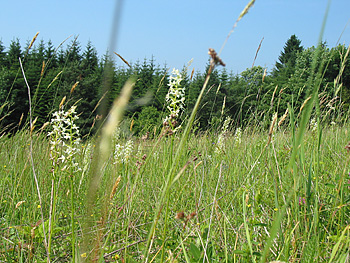Nature protection » Plant species protection
Plant species protection
After some floristic research carried up in the area of the Magura NP many precious vascular plant species were found. Many actions and projects are undertaken to keep the rare and protected species in good condition.
1. Non-forest ecosystems mowing
- mechanical mowing of fresh and dry meadows (every 2 years) and heath lands (every 5 years)
- manual mowing of wet meadows and mires (every 3-5 years)
This type of activity is carried out in particular season appropriate for the priority species. It is aimed at the improvement of the condition of precious species population which often loose the competition with strong and expansive plants. Those very precious plant species are: the orchid family (7 meadow species), Gladiolus imbricatus, Siberian Iris Iris sibirica, Meadow Saffron Colchicum autumnale .

Lesser Butterfly-orchid (fot. Joanna Pawelec)

Meadow Saffron (fot. Stefan Michalik)
2. Bush and young trees removing
- mechanical
- manual
Young trees and bushes are being removed from meadows to stop the ecological succession. It is being done every 3 – 5 years and it prevents meadow species from being displaced by forest ones. This type of activity is being carried out especially on dry meadows with Carline Thistle Carlina acaulis and some fragments of heath lands with Stag's-horn Clubmoss Lycopodium clavatum.
3. The stabilising of natural habitats for precious forest species by keeping or improving the water conditions, partial exposure of overshadowed sites or sites choked up by young trees and bushes. This type of activity protects among others 7 species of orchids, Columbine Aquilegia vulgaris and Hart's-tongue Phyllitis scolopendrium.

Columbine Aquilegia vulgaris (fot. Joanna Pawelec)

Hart's-tongue (fot. Joanna Pawelec)
Searching and protecting the old varieties of fruit trees, which survived in deserted villages in the area of the Park, became recently quite important issue. Healthy trees are being catalogued and exposed when needed. If the trees are old or ill and they may not survive winter, some pieces are being taken for further grafting.


